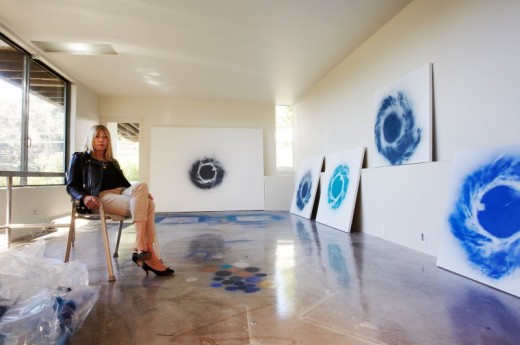Kim Gordon: Going Solo After Sonic Youth, and Why She Identifies With ‘Girls’
There is a certain school of thought that says Kim Gordon—”musician, vocalist, visual artist, record producer, video director, fashion designer, and actress,” according to her ever-expanding Wikipedia entry—is the coolest person on the planet.
Gordon, for her part, cannot possibly understand why anyone would think that, which has the effect, of course, of making her even cooler.
On a recent Monday afternoon, the former Sonic Youth bassist was high in the hills above L.A.’s Laurel Canyon, waiting to lead a group of local art students through her latest exhibition,Coming Soon, a series of 24 “wreath” paintings that she had hung, placed, or casually propped up throughout the Fitzpatrick-Leland House (1936) by legendary modernist architect R.M. Schindler.
“This turned out to be a perfect place,” Gordon said as she gazed through a long bank of windows toward the green slopes below. “I was worried it would be too ‘nice’ or something, but what’s great about the architecture is that it’s just so quiet.”
In Sonic Youth’s 1994 video “Kool Thing,” Gordon wore pink lipstick and silver hot pants and sang about “male, white, corporate oppression” over a squall of feedback. In conversation, she is as quiet as Schindler’s architecture. Her sentences take shape slowly, tentatively. Sometimes her voice fades out before she reaches the end of a phrase, like a radio losing reception. “Anyway,” she’ll mumble. Her smile is an ellipsis. She’ll be 61 on April 28.
Gordon, an L.A. native, has lived in Western Massachusetts for decades now, but tapping at her iPhone in Schindler’s kitchen, she looked right at home: strappy shoes, large sunglasses, a diaphanous dress, and a stack of brass bangles on her left wrist. She explained how she arrived at wreaths. “I was searching for something suburban—some low form of decoration that could be transformed,” she said. “I liked the idea of something that could actually be nothing, or mean nothing. Something that people project onto.”
To her, the everyday symbolism of the wreath—harvest, Christmas, mourning, and so on— seemed to evoke “the liberated woman of the 70s… a little bit city, a little bit country.” Gordon picked up a pair secondhand and began to stencil then onto blank canvases with spray paint. Some faced outward. A few were reversed. Some were centered. Others weren’t. The finished paintings resembled grainy, multicolored photograms: the bright, spiraling form of the wreath, the fine filigree of the branches, the white void in the middle.
For Coming Soon, Gordon’s initial plan was to make and then display her wreath paintings in a low-budget California tract house. “I’ve always been fascinated by those model-home communities,” she said. “All the branding, you know? The whole idea that that there’s this fantasy of what your life is going to be if you move in.”
But once Gordon saw the Schindler, she was sold.
Unlike most of Schindler’s houses, which were designed for specific clients, the Fitzpatrick-Leland House was built on spec—a promotion of sorts for a new hilltop housing development. The angular, terraced structure was anything but anonymous—Schindler was the most idiosyncratic of L.A.’s early modern masters—but the spirit of the place was still aspirational. Gordon holed up in the basement game room for two-and-a-half weeks to paint.

All artwork © Kim Gordon. Courtesy of the artist and Gagosian Gallery. Photography by Jiro Schneider.
As she wandered through Schindler’s interlocking, sunlit spaces a few days after her opening, the artist’s pride was palpable. “Can we take that down?” Gordon asked, gesturing toward a “No Access” sign that someone had taped to the balcony door, presumably to prevent drunken partygoers from plummeting into the gulch below.
The entire house was hers now, and everything was there for a reason: the Deep Sea Wreath suspended in front of the living room’s floor-to-ceiling windows; the massive Dark Indigo Wreath wedged like a misaligned headboard between the pillows and the wall behind the bed; the triptych of wreaths (Copper, Silver, Goldchrome) looming over a desk upstairs; a second Deep Sea Wreath hanging above the bathtub; the logs in the fireplace; the paperback copy of Joan Didion’s Slouching Toward Bethlehem on the nightstand; the black tights flung on the floor beside the bed.
Gordon tottered down the narrow stairs to her basement studio. More wreaths were leaning against the wall; a large ball of clear plastic was crumpled up in the corner, and splotches of overspray in various colors stained a transparent sheet that Gordon had affixed to the concrete floor before going to work. “I hope to be able to take part of the floor with me,” Gordon said, brushing her blond bangs from her forehead with the tips of her fingers. “I kind of wanted it to feel like it was a process, like some of the paintings were ready to be taken out and put into your home.” The overall effect was of an unseen housewife trying to break free—a woman who had bought into the fantasy of her new home, and her role as homemaker, but who was now compulsively transforming her decorations into swirling portals and grasping at some sort of artistic (or even cosmic) escape.
“After you’ve graduated you’re supposed to be an adult now and go out into the world, and you’re still not formed. It’s an interesting … horrible, horrible time.”
Gordon has always been fascinated by redecoration. At 5, she knew she wanted to be a visual artist. Her father was a sociology and education professor at UCLA; her mother was “a homemaker with creative tendencies.” Their house was filled with African drums, and her elementary school was big on “learning by doing.” But when Gordon first moved to New York, at the age of 26, she didn’t have anywhere to show her work. So she would “just do something, write about it, and get it published somewhere—documented.” What she did, mostly, was redecorate. “I was thinking of interior magazines, where they take pictures of rooms and things,” she recalled. “But it was kind of, like, a lo-fi version of that.”
Her first subject was the artist Dan Graham, who lived downstairs. “He had his bathtub in the kitchen,” Gordon said. “It was a typical railroad apartment. He never cooked, so I got rid of the oven. I did a watercolor of Blondie–of Debbie Harry–because I was writing articles about girl groups. I put this Italian vinyl tile in his bathtub-kitchen area. He was always talking about it, whenever we’d go into a bank foyer. He was, like, fascinated by it, so it was a little bit like ‘careful what you wish for.’ Then I wrote about it and it was published in File magazine.”
Other, similar interventions followed: ordering a monogrammed phone cover for the nomadic L.A. gallery FARR; filling the White Columns office with chairs from various people’s homes and repurposing it as a dining room.
At the time, Gordon called her work Design Office. “The original inspiration was to have a fake group,” she said. “It was basically just an excuse to hang out. I was interested in the relationship between art and design, and public and private spaces, and reversing those ideas somewhat.” When Gordon joined Sonic Youth, she put Design Office on hold. “I was kind of freaked out by the art world in the 1980s,” she admitted. “Just the money thing. All the competition over artists.” But she “literally never really thought of [herself] as a musician.”
Asked how that was possible—Sonic Youth lasted 30 years and released 15 studio albums—Gordon said there’s always been “big gap” between how she sees herself and how her fans see her. “I just thought of it as something I was doing,” she continued. “You’re in your own head, and you forget that people don’t know you. They just assume and project stuff onto you. And then it’s like, ‘Why would you ask me who my favorite bass player is?'”
She laughed. “It was just… odd.” When Gordon and Sonic Youth guitarist Thurston Moore divorced in 2011 and put the band on “indefinite hiatus”—they’re unlike to reunite—Gordon revived Design Office “as an umbrella for everything I do, almost like a factory or something.” (Gordon found out that Moore had been cheating on her when she saw a text message from Moore’s mistress on his phone; despite months of counseling, he was unable to end the affair.) Gordon pointed to the clear plastic covering on floor of the Schindler studio. Amid the spray-paint stains she had stenciled the Design Office logo.
At first, Gordon was worried about going solo, both artistically and musically. (She now performs with the noise guitar duo Body/Head.) “Being in a band was great because your own ego wasn’t out there,” Gordon said. “You’re sort of protected. But at the same time, it’s nice to be able to make a decision yourself. It’s been better than I thought it would be.” A few weeks earlier, Gordon had appeared on an episode of Girls; Hannah Horvath’s plight had made her think about her own path to artistic independence. “After you’ve graduated, you’re supposed to be an adult and go out into the world, and you’re still not formed,” she said. “It’s an interesting … horrible, horrible time.”
Did she say that from personal experience? “I mean, I always wanted to be an artist, but I didn’t know how to get there and do that. Now I have a daughter who’s 19, in her second year of art school, and I find her and her friends fascinating. They seem so smart and so together. So much more together than I ever was.”
An assistant appeared with Gordon’s salad. Students clutching sketchbooks were beginning to gather in the yard—students who were probably looking at Gordon and thinking, “That’s the life I want. She has it all figured out.”
“Oh God no,” Gordon said. “I never felt like I had anything really figured out. When I was a teenager it was all about teenagers having an ‘identity crisis.’ That was the phrase that was used. But in my early 20s, I was still like, ‘When am I going to be over that?’ And I almost resisted it because I felt like once I decided who I was, I shouldn’t trust that—I would be comfortable and I wouldn’t be creative. It’s this feeling of ‘you’re never there.’ You’ve never arrived. For a lot of artists it’s like, you never feel good enough. I think that’s also particularly true with women. And in Girls you see that. Those are the things that are timeless.”
(185)














